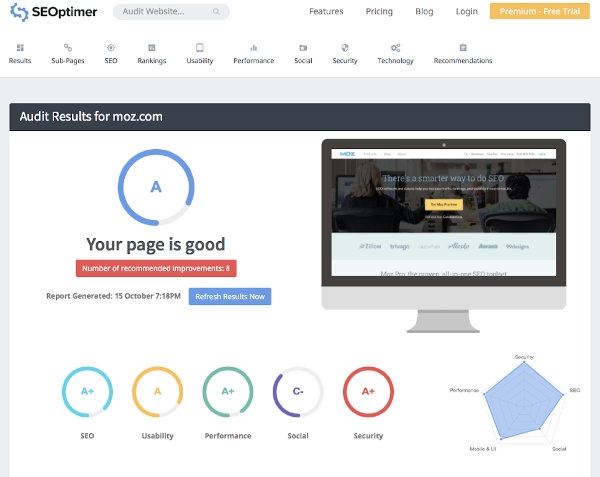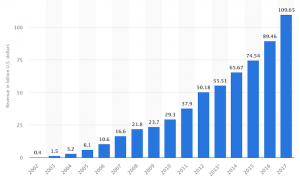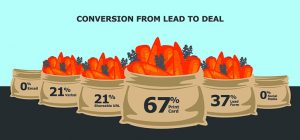Improve Your SEO with these 10 Actionable Tips, Smart Recommendations and Helpful Tools!
Search Engine Optimization (SEO) is a critical part of any solid digital marketing strategy. Great SEO can impact both the quality and the quantity of traffic to your website. It’s one of the most powerful organic forms of marketing out there. To be effective, every page of your website should optimized. But what does this really mean?
Your website pages need to have a purpose. Delivering on that purpose with high-value and relevant content formatted in an easy-to-digest format should be your primary focus.
It’s all about creating a unique and valuable experience for your audience… this is the human side of SEO! Complementary to that is the machine side of SEO… the mechanics of ensuring your website pages are optimized for Search Engine Results Pages (SERPs).
There are no quick fixes for proper SEO to ensure you land on page #1 of a SERP. It takes time and effort to ensure your pages are optimized for the best experience for your target audiences as well as discoverability by search engines.
With a bit of determination and persistence, applying these 10 actionable tips can help you to improve your SEO dramatically.
Did you know that 68% of online experiences begin with a search engine (ahrefs)? Or that 49% of marketers report that organic search has the best ROI of any marketing channel (Search Engine Journal)? In October 2020, Google accounted for over 70% of all global desktop search traffic, followed by Bing at 13%, Baidu at 12%, and Yahoo at 2% (NetMarketShare).
Not surprisingly, Search Engine Optimization (SEO) is considered a top priority for most online businesses. But, cracking the Google Search Ranking algorithm is no easy feat! According to Backlinko, Google’s search algorithm uses more than 200 factors to rank websites! Optimizing for all of these factors is often too time consuming and resource-intensive for many businesses.
Luckily, it’s not an all-or-nothing thing with SEO. Every optimization point you make is one step closer to improving your search ranking. So, where is the best place to begin? Start with the low-hanging fruit… the things that you can adjust easily that will have a big impact on your site. With a little bit of effort, you can make big changes by focusing on these top 10 factors to improve your SEO.
1. Complete an SEO Audit
Knowledge is power! If you really don’t know where to begin, auditing your website for Search Engine Optimization (SEO) is a great starting point. Knowing what is already optimized, what needs work, and what is broken gives you an idea of where to focus your efforts.
There are several free and paid tools that can help with understanding your current state of SEO. These tools provide you with analytics and recommendations regarding page speed, SEO elements, broken links, site security, and more. Most tools provide insights for the most common SEO issues, but each is unique in how they analyze the data and recommend solutions.
While this isn’t anywhere near a complete list of SEO tools, we are providing some of our favorites for completing an SEO Audit (most with a Free version!):
SEOptimer
SEOptimer is a great FREE online tool (they have a Pro version as well) to get a quick glimpse of how your website is performing on many factors related to SEO. You can run the tool on your own website, or another website, and check your “grade” across 5 different categories: SEO, Usability, Performance, Social and Security.
Within each category, they provide insights on a few key factors that go into the grade. Also included are recommended improvements. This is a handy tool to check your basic SEO functionality.
SEMRush
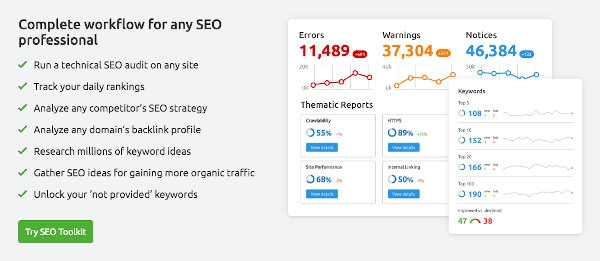
SEMrush has both a FREE version (limited to crawling 100 pages and limit on features) as well as a comprehensive Pro version of their tool. Even with the limited FREE version, you get a ton of insights.
There are many features with this tool, including an enhanced dashboard for quick access to what’s important to you. From the Dashboard, you can quickly see Domain Analytics such as organic/paid keywords and traffic, the domain authority, your site health and visibility and much more.
Going deeper into the Site Audit, you get a number score for the overall health of your website. The audit shows your critical errors, warnings and notices which all provide insights as to what needs to be addressed. This is a robust tool with lots of bells and whistles, if you are looking to take your SEO to the next level.
SiteChecker.Pro
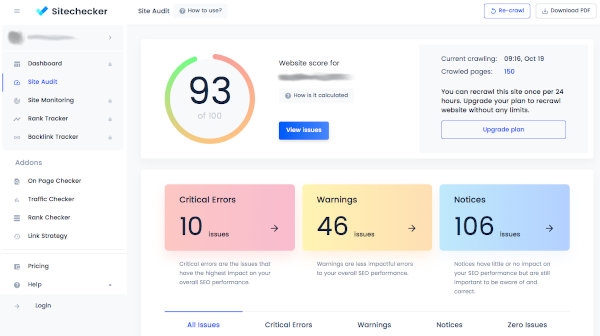
SiteChecker.pro has a simple free online audit as well as a pro version that unlocks many additional features. With the free audit, you can crawl 150 pages and get a quick glimpse of critical errors, warnings and notices.
SiteChecker.pro gives your website an overall score as well. You can review your errors, warnings and notices (limited access) and make changes to see if you can improve your score (you may re-run the crawl once per 24 hours.
Even with the limited data, you can get a good sense of the big issues you should focus on to improve your site. With the pro version, you get access to a complete dashboard, site monitoring, rank tracker and backlink tracker… as well as the ability to get even more functionality with add-ons.
Overall, this is a pretty helpful tool for understanding what changes and fixes you can make to improve your website and SEO.
Screaming Frog SEO Spider
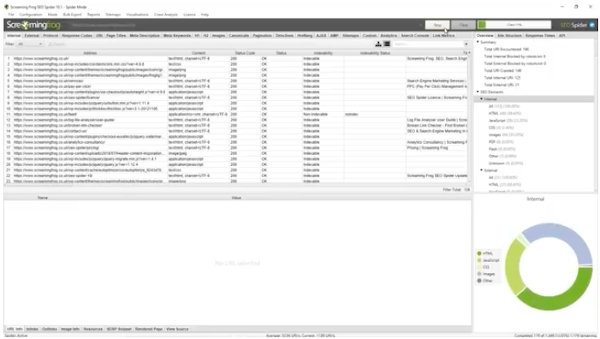
Screaming Frog SEO Spider is a desktop website crawler that identifies the most common SEO issues. You can download and audit 500 URLs with the free version or purchase a license to remove the limit and access advanced features. But, the free version is packed with a ton of data points that can be super helpful in optimizing your site.
With this tool, you can analyze your page titles and meta descriptions, find broken links, discover duplicate content, find missing content, audit your redirects, and so much more.
This crawler is great for seeing the granular details of your website and SEO data and breaks it down into manageable sections that pinpoint areas to focus on. We love this tool and use it in conjunction with many of the online tools.
Moz
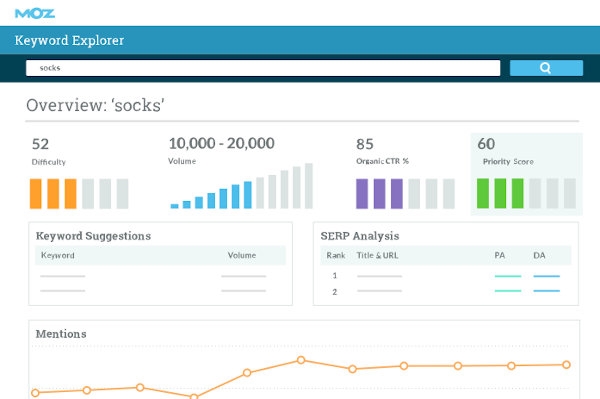
Moz offers some of the best free and pro SEO tools out there. Among their free tools are a free domain SEO metrics tool which shows your your overall domain authority, your top pages by links, your top linking domains and some basic information about your keywords.
Other free tools include their keyword explorer, link explorer, and Moz bar which gives you important search and social metrics for every page you visit, right from your Chrome browser.
The Moz Pro solutions provide even more metrics to really get into the details of your website and SEO data. The Pro versions include an advanced Keyword Research tool, Rank Tracking tool, Site Crawl, On-page Optimization and customized reports. Moz is a leader in SEO analytics, so you really can’t go wrong with any of their tools!
2. Ensure Your Website is Mobile Optimized
It’s no longer just about having a responsive website. If your website isn’t optimized for a true mobile experience, then you are at a big disadvantage.
In 2016, Google first launched their mobile-first indexing initiative, strongly suggesting that all content should be optimized for mobile. In early 2020 Google announced that they would be switching over to mobile-indexing by the Fall of 2020. Due to COVID, this date has been pushed out to March 2021.
So what’s this all mean? Going forward, you really must have a mobile-optimized site. Your desktop content and your mobile content must align if you maintain separate sites.
According to John Mueller, Webmaster Trends Analyst at Google, “We now almost completely indie with a smartphone Googlebot. Content only visible on desktop will be ignored. *All* content must be reachable/seeable by a phone, including any comments, structured data, images, videos, etc you want to have indexed.”
The best way to improve your SEO and ensure your website is Mobile Optimized is to build it that way. But, there are some tools that you can use to help determine whether your content is mobile optimized or not. Here are a few places to start:
Test My Site (Think with Google)
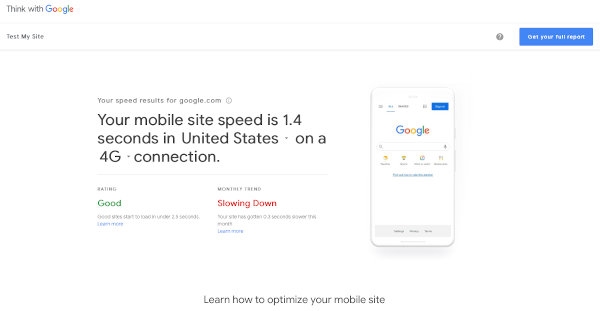
Test My Site (Think with Google) is a free tool offered by Think with Google. You can run the analysis for any domain and it will, in turn, give you your overall mobile page speed in seconds on a standard connection (4G for example). The results indicate how your mobile site is performing as well giving your pointers on how to optimize your mobile site.
The first area that is addressed is mobile site speed. They claim that improving your load time by 0.1s can boost conversion rates by 8%! Wow… that’s a great reason to work on those load times! The nice thing about this tool is that it gives your recommended fixes as well!
Other areas of improvement include personalization and offering a seamless experience to mobile visitors. While the recommendations are a bit generic, the essence is that your site should be optimized for the mobile experience in many ways.
Google AMP Test
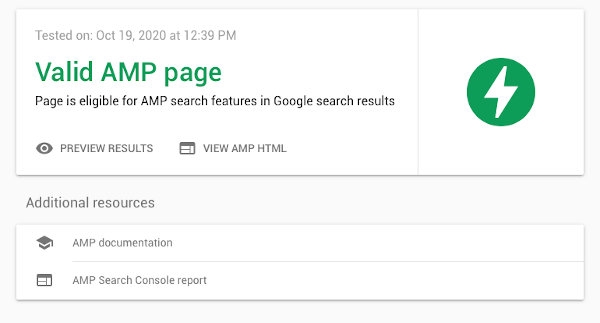
If you are taking advantage of AMP pages, you can test them to ensure they are valid using Google’s AMP Test. This is a super simple tool that will test to ensure your AMP pages are valid with no technical issues.
Google Mobile-Friendly Test
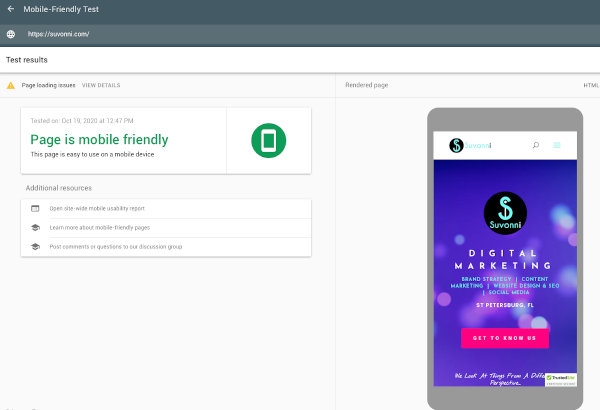
The Google Mobile-Friendly Test can help determine how easily visitors can use your page on a mobile device. While not a true indication of a mobile-first strategy, this tool can give you an idea of how well your pages are viewed on mobile devices.
3. Optimize for Page Speed
Optimizing your page speed (how long it takes for your page to load and become fully functional) is a significant way to improve your SEO dramatically. Google has indicated that site speed plays a major factor for website experience and has noted that it is one of the signals used by the algorithm to rank pages.
And… it’s not just desktop speed that matters. As noted above, mobile site speed also plays a critical factor in the overall performance of a website.
Websites that load in under 3 seconds perform best. But with the features and elements available to make websites stand out…(think video, images, animations, graphics, interactive elements, etc.), it’s often a huge challenge to accomplish this.
There are several things you can do to try to reduce the overall size of your website pages and to ensure they are optimized to load as quickly as possible. But first, let’s look at a few tools to test your page speed:
Google Page Speed Insights
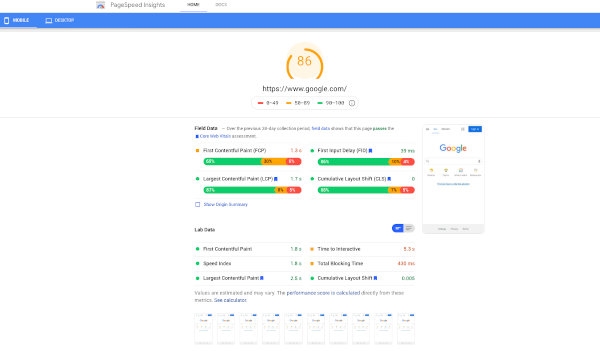
Google Page Speed Insights is a great tool that provides you with an overview of both your desktop and mobile page speed, along with key opportunities for improvement and diagnostics. With this tool, you can see how quickly (or slowly) your page loads, what takes the longest to load, how long before your site is interactive and much more.
GT metrix
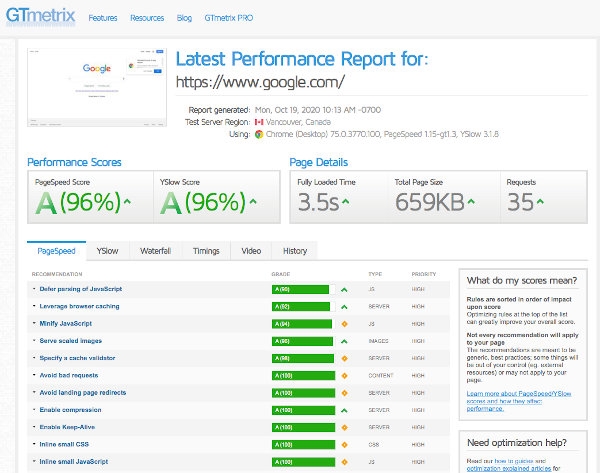
GT metrix is another great free tool to test your page speed performance. This tool gives even more data points than the Page Speed Insights along with recommendations for fixing issues. While not all recommendations apply to every website, generally they provide best practices to ensure your website will load quickly.
You can view both your PageSpeed Score and YSlow Score with GT metrix. It also gives page details including fully loaded time, total page size and number of requests.
To optimize your site for quick loading, you may have to weigh the tradeoffs between features versus functionality. Keep in mind that Google doesn’t care if you have a beautiful animation on your site… they only care about how long that page takes to render to a visitor.
Keep that in mind as you try to optimize your website. There are additional tools you can utilize to help your site run more efficiently.
For WordPress websites, it can often take a bit of fine-tuning to get just the right combination of settings to ensure your site runs as quickly and efficiently as possible without breaking. Here are a few of our tried and trusted WordPress plugins to help optimize your site’s performance:
WP Fastest Cache
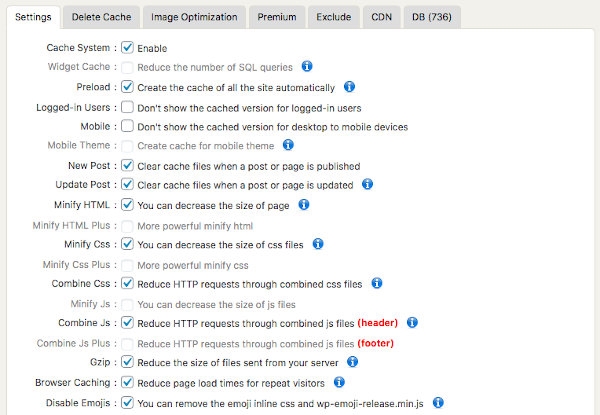
WP Fastest Cache is a WordPress plugin for optimizing your website performance and has both Free and Premium versions. Simply activating the Free version will help with your overall site performance through desktop caching, minifying HTML and CSS, combining CSS and JS, utilizing GZIP and enabling browser caching.
The Premium version takes it a few steps further with mobile and widget caching, additional minify and combine settings, eliminating render-blocking JS, image optimization and several other functions. We’ve found that WP Fastest Cache has the least amount of website/theme breakage instances and is less complicated than alternatives such as W3 Total Cache or Super Cache.
Hummingbird
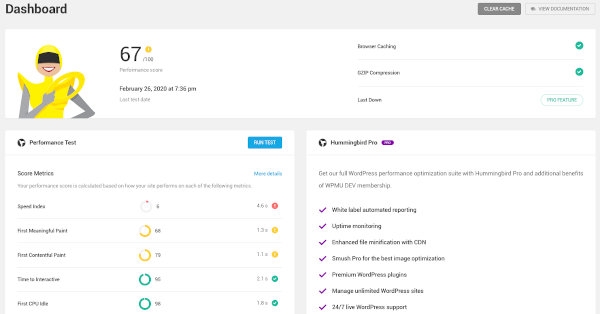
Hummingbird is another great WordPress plugin built to help optimize the performance of your website. Hummingbird also has a Free and Pro version of their plugin. One thing we love about this plugin is that it will perform a scan of your website, identifying specific areas for improvement that can then be completed within the tool. Additionally, the Free version of Hummingbird offers help with caching, asset optimization, GZIP conversion and much more.
The Pro version gives you additional minification settings, image optimization, uptime monitoring and several other features. Overall Hummingbird is a solid plugin that can give your website the performance boost it needs to load fast.
4. Choose Your Keywords Strategically
Keywords are a strategic element to improve your SEO. Choosing the right keywords or keyword phrases is as much of an art as it is a science. Every page on your website should be optimized around a unique keyword or keyword phrase.
But what does it mean to optimize for a specific keyword? The key thing to remember is that your website should be providing content that your target audience is looking for.
Knowing your audience is the foundational element you need to truly excel at strategically choosing your keywords. Know what questions your audience is asking, what problems do they need solved, and where/how are they searching for these things.
Remember, websites don’t actually rank for keywords… individual pages are what rank. Therefore, when you create high-quality, high-value and relevant content on a page-by-page basis, your naturally creating your keyword strategy.
Keywords and phrases should come naturally when you approach your content this way. But, you will still need to put a bit of effort into researching the optimal keywords or phrases. Additionally, you may need to make a few small changes to ensure you have the right density of your chosen keyword based on your overall content length or to add your keyword to alt tags, etc.
Your keyword should be placed within your content strategically. It should be included in your Header Tags, your Title Tag, your Meta Description and your image Alt Tags. Optimally, your keyword should be in your page URL as well. Actual placement is key too – be sure to include your target keyword within the first 10% of your content and ensure it is evenly dispersed throughout your page.
One of the biggest mistakes you can make with keywords is to abuse them. Keyword stuffing is never a good idea. It’s obvious to your website visitors as well as to the search engines… and you will most likely get penalized for this type of abuse. You can avoid this problem by making sure your content is written for humans first, then optimized for search engines.
The other big mistake people often make with keywords is not doing the proper research to choose their keywords strategically. Longer keyword phrases often perform better than popular/common single keywords because there is less competition and a more highly focused search intent.
Take for example the keyword “boots.” If you do a search on “boots” on Google, you will get a smattering of big shoe brands on page one. It’s high competition and low focus. On the other hand, if you search for “hiking boots for kids” you are going to get a more narrow search result with more relevance.
While the search volume for a single keyword may be enticing at first… the high amount of competition and lack of search focus doesn’t really make for a great strategic keyword choice. Long-tail keywords, with lower search volume but more niche-focused will have less competition and more search intent.
It’s a fine balance between knowing what your target audience is searching for and narrowing down your focus to be discoverable.
So how do you narrow down your keywords and choose them strategically? We’ve got a few tools that can help with that:
Moz Keyword Explorer
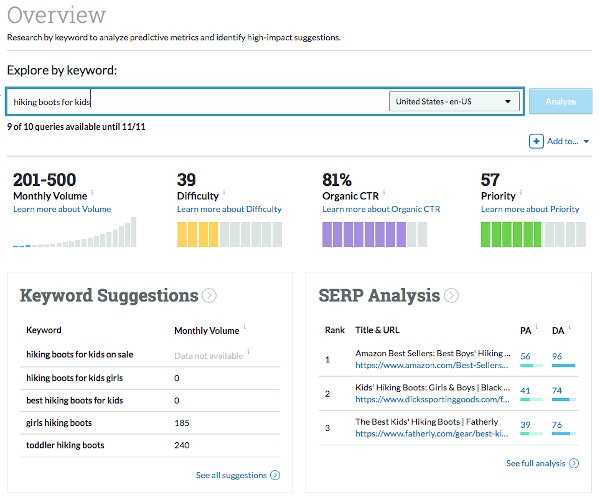
With the Moz Keyword Explorer tool, you simply add your keyword or keyword phrase and in return it will show you important factors such as estimated search volume, the difficulty score (how difficult it might be to rank for the chosen keyword), potential organic CTR and priority level (your sweet spot).
The tool also provides keyword suggestions that include monthly volume and relevancy as well as a SERP Analysis that shows organic results on page one. Overall this is a very helpful tool for narrowing down your keyword choices.
Google Keyword Planner
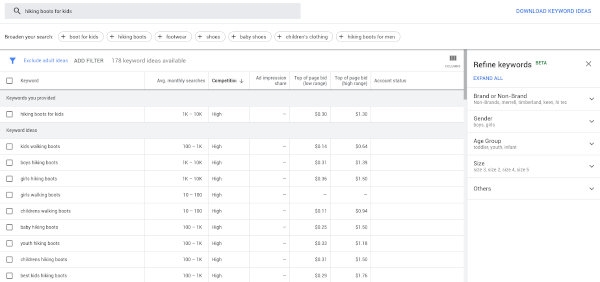
Google Keyword Planner is another great tool to help you find just the right keywords. With this tool, you can discover new keywords (that can help you reach people that are interested in your product or service), explore concepts (see how many keywords are related to each concept), and refine your keywords.
Google Keyword Planner uses larger search volume clumps, but still provides good data on overall search volume, level of competition, etc. to help you refine your keyword choices.
RankMath On-Page SEO Checker
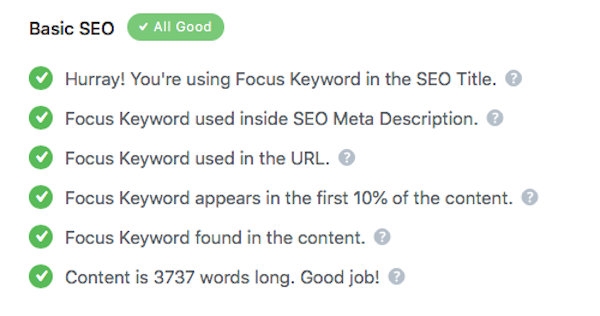
RankMath is one of our favorite SEO page checkers. Once you have chosen your keyword and tweaked your content appropriately, you can use RankMath to further improve your SEO. This helpful WordPress plugin provides guidance on your use of keywords as well as other basic SEO functionality including your title, meta description, and more.
Simply input your unique keyword and RankMath will grade you on several basic SEO elements to ensure you’ve got the right placement, quantity and more. Tweak your page to get a better grade.
5. Optimize Your Titles to Capture Attention
Your page title is one of the simplest, yet most powerful things you can optimize for SEO. But, this doesn’t mean you don’t have to be strategic about it! To the contrary, your title is such an important factor that you absolutely must approach it strategically.
So, let’s talk about the technical aspects first… keep your title tag close to 60 characters (580 pixels). If it is too short, you are missing out on an opportunity to gain attention. If it is too long, your title will become truncated and may lose it’s impact.
Do also ensure you include your keyword in your Title, and as close to the beginning of the title as possible. And most importantly, don’t duplicate titles! Use unique titles for every page and post.
Now, on to the details of perfecting your title. This all goes back to knowing your target audience and understanding what they are searching for. When you frame your title with your audience and their needs in mind, your CTR will increase dramatically. Including power words and/or numbers can also help convey the importance of your title.
Avoid click-bait type words and phrases that over-promise or seem spammy. So, instead of a title like “Hiking Boots for Kids | Your Company”, think more along the lines of an enticing title such as “The 12 Most Durable Hiking Boots for Kids | Your Company”
Think of your Title tag in the same terms as a Subject Line… you have to grab someone’s attention with a few strategic words.
RankMath Power Words
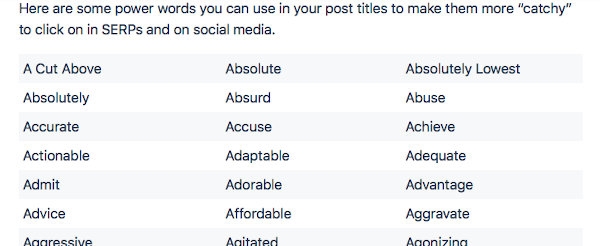
Check out RankMath’s blog all about writing powerful headlines/titles. Included in the article is a list of power words you can include in your titles to make them really stand out.
6. Perfect Your Meta Descriptions to Improve Credibility
Much like Title tags, your Meta Descriptions play a big part in your search results. Your Meta Description, or as Google affectionately refers to it, “Snippets”, can often be the deciding factor determining whether or not someone clicks on your link. It should complement your Title and be relevant to the content of your page.
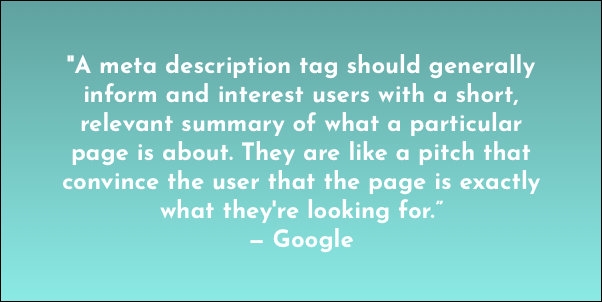
From a technical standpoint, your Meta Description should be about 160 characters in length (980 pixels) if you don’t wish for it to be truncated. That said, Google recently did away with their character limit for Meta Descriptions and some independent studies have shown that longer meta descriptions perform even better. Best bet? Test out some different lengths and see how your own pages perform.
With less emphasis on exact length, you should focus on ensuring your Meta Description gives an accurate, relevant, and interesting perspective to your page content.
Always include your keyword within your description, but avoid using more than once as it may appear as keyword stuffing. Like keywords and Titles, your Meta Description should be unique for each page of your website.
Your Meta Description should do exactly as it says… it should describe the contents of your page. The Meta Description is oftentimes overlooked as it may auto-fill with the initial content of your page.
But, to improve your SEO, you should always customize your Meta Description to ensure it is enticing, relevant, rich, and includes a reason why someone should click through to your page.
Approach your Meta Description much like you would a Headline or brief excerpt. You have limited space to attract attention that will get someone to take the next step by clicking through to your page. Use smart copywriting approaches but always remain true to the content of your page.
7. Choose Relevant & Optimized Images for Complementary Visual Content
Visual content is an important element of most web pages. Visual content can come in the form of images, videos, graphics, emojis, memes, and more and can help us to comprehend and understand concepts quickly and easily.
But did you know they can also help to improve your SEO? Using relevant and interesting visual content helps to draw your visitors in and can provide a great user experience when utilized to enhance your written content. You can take that one step further by ensuring your images/videos are optimized.
Your visual content should be sized and compressed to meet the needs of your page. Choosing the right sized images and videos and compressing them before you upload them to your website helps with keeping your overall page size in check which in turn helps with your page speed.
You can also utilize an image optimization tool to help with compression and resizing images as needed. A few of our favorites include:
Smush
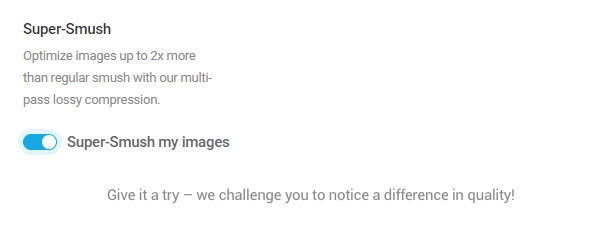
With an image optimization tool like Smush, you can bulk compress images as you upload them in WordPress. You can Super-Smush images which essentially strips out all data (except for what is needed for SEO) without compromising image quality.
You can also enable other features that help with your page loading time such as Lazy Loading images, changing .png images to .jpg images and utilizing a CDN for super fast loading.
GIMP – GNU Image Manipulation Program

GIMP is a great free open-source image editor that allows you to effectively size and save your images for the web. This tool is loaded with functionality and ability to edit images as well as adjust the level of compression, file type and so much more.
Using the Alt tag allows you to write a descriptive overview of your image. While meant to aid those who cannot view the image, the Alt tag can also serve to boost your overall SEO. Using your unique targeted keyword within your Alt tag helps to ensure your visual content is relevant for your page and complements the written content included.
If using video within your page, be sure to also write out the transcript on your page to ensure Search Engines know what your page is all about. Visual content can be a great complement to your written content but often doesn’t have enough SEO juice to power a page solely.
8. Create High-Value Content Written for Humans, Optimized for Machines
This is such an important element that perhaps we should have started with it! The content of your page is the subjective element of whether or not visitors find value in what you are sharing.
Does your content fulfill the promise you offered up in your Title and Description or was that misleading? Click-through rates may be an indication that your Title and Description are spot-on, but if you have a consistently high bounce rate, then there may be deficiencies in your content.
As mentioned before, when you create high-quality, high-value content written for your target audience, your keywords will naturally become evident. You should always take the approach of writing for humans, then optimizing for machines!
When you write content for search engines (i.e. with your keyword as your focus first), it doesn’t flow naturally. It’s forced and often leads to keyword stuffing… which will have a negative impact on your search ranking. Most people can see through this type of content and will simply choose to quickly navigate away from your site.
Keep in mind, It’s the job of search engines to return the most useful and relevant information to a searcher. Thus, ensuring your content is highly relevant and useful (more so than other content out there), the likelihood of appearing higher in search rankings goes dramatically up.
With an Audience-Centric approach, focus on content that helps your audience find what they are looking for, answers the questions they have, gives them the recommendations they need or provides them the entertainment, education or information they seek. Content creation is a powerful tool in your marketing arsenal… take the time to create content that your audience craves!
In addition to ensuring your content is high-value, you’ll also need to think about how you deliver that content. Remember, the focus should be on your target-audience. Think about how they prefer to digest information… and look to all the unique and engaging ways you can deliver your content and messages to them.
From long-form blog articles and data-driven research reports to listicles and reviews… the many forms and formats with which to deliver your content are endless. The key is to capture and retain the attention of your intended audience. Not only will this drive conversions but can have a big impact on improving your SEO.
9. Utilize High-Quality Links to Support Your Content
High-quality linking is another critical aspect that can dramatically improve your SEO and drive more traffic to your website. This applies both to internal linking and external linking.
A website page that has no linking is seen as a dead-end for search engines… which is not a favorable thing. Ensuring you have relevant, credible and useful links on your pages is an SEO best practice.
Many people mistakingly think that by putting outbound links (links to other websites) on their website pages will distract from their own content and send people off from their site. And while you may drive traffic to other sites, the value in adding high-quality, relevant links to your pages is that you build your credibility, establish relationships with other businesses and ultimately drive more organic traffic back to your site.
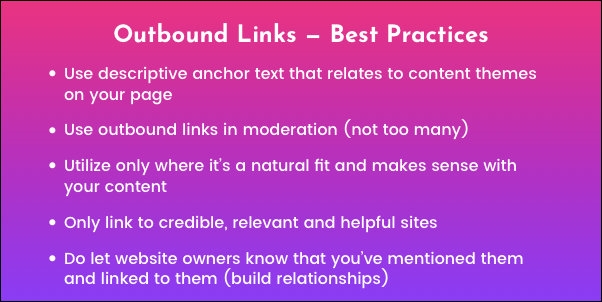
So how do external links help with SEO? External links pass link equity (ranking power) from an outside source (think of it like a 3rd party endorsement). For this to happen, the link must be a “do-follow” link, indicating to search engines to follow the link (as opposed to a “no-follow” link which tells the search engine not to follow the link).
Including external links on your page helps you pass a “vote” to those pages you link to. When you add relevant and highly credible links on your page, with smart anchor text, you are also boosting your own page relevance. You are showing the search engines that you are providing great content, with helpful links to additional great content that your audience may find useful.
The ultimate power of external links comes from the relationships you may build with sites that you link to. Getting backlinks (links to your website from other highly credible websites) helps to boost your credibility, relevance and authority.
10. Use Header Tags Strategically
One of the single most important SEO elements on your page just may be the H1 Tag! Header Tags (H1, H2, H3…) are important for both structuring the content of your page for usability and for SEO purposes. Search Engines use cues from Page Titles, Meta Descriptions and Header Tags to infer the context of a web page.
The H1 Header is typically the largest and most prominent tag at the top of the page. Many CMS (Content Management Systems) like WordPress will automatically assign a Header Tag to your page title, but not always. It’s important to think strategically about your Header tags to improve your SEO.
Think of and H1 Header Tag like the Title of your book, the headline to your article or the overall topic you will cover with your content. It should be enticing, relevant and must contain your target keyword (though don’t over-do it… as keyword stuffing in an H1 will be flagged as spam!). Keep in mind you should only have one unique H1 per page and across your website.
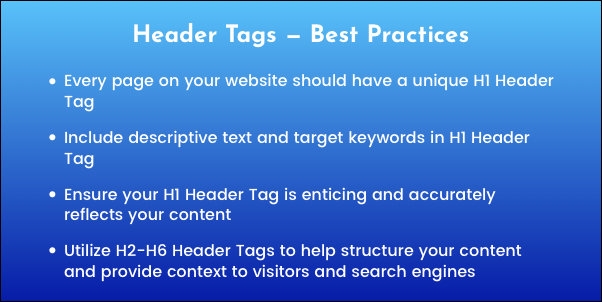
Header Tags are hierarchical… meaning an H1 is the most important, followed by H2, H3, H4, etc. The H1-H6 Header tags can be used strategically to help structure the content on your page.
Think of H2 Headers as the chapters of your book. H3 Headers can be used as sub-headings and to emphasize key information under each H2 Header, etc. And while H2-H6 Headers tags don’t have as much impact on SEO as your H1 Header Tag, they are still used as cures for how your page is structured from a contextual standpoint.
One of the biggest mistakes made on website pages is the misuse of Header Tags. Often times, Header Tags are being used to format and style a page. What happens is that you end up with a page that has multiple H1 tags, random words being used for H2-6 tags and many times, no H1 tags being used at all.
You can easily check your H1 Header Tags in a tool like Screaming Frog (listed above) or simply by inspecting each page using developer tools.
Closing Thoughts
There you have it… 10 of the most actionable ways to improve your SEO! While these aren’t the only ways to give your website an SEO boost, they are generally the easiest to fix and can have the biggest impact. The google search algorithm changes often. Staying on top of the latest best practices for SEO is a must for every business with a website.
It’s important to note that SEO is not a set it and forget it task. Continuously monitoring your pages and performance and tweaking your website pages accordingly will help ensure your SEO success.
Following website design best practices and really good SEO can be the key to your business success. With strategic changes to improve your SEO, you’re giving yourself the best chance at ranking higher in the SERPs (and becoming discoverable by a wider audience).
Digital & Social Articles on Business 2 Community
(28)

